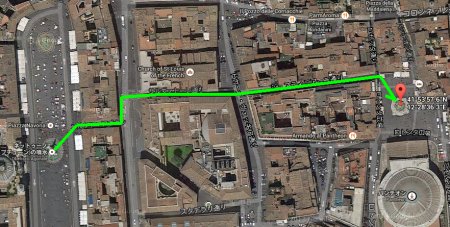
|
| |

|
Macuteo Obelisk
| Present Site: | Piazza della Rotonda, Rome, In front of Pantheon. N 41°58'57.6"(41.899333) E 12°28'36.3"(12.476749) |
| Pharaoh: | Ramses II (The 19th Dynasty, reigned 13tn century BC) |
| Measurement: | 6.34 meters high for obelisk itself, 14.25 meters high including pedestal |
| Stone: | Red granite |
About The Site:
This obelisk stands in the square in front of Pantheon, which is one of most well-known historical site in Rome. Every guidebook refers to Pantheon, and the most sightseeing tours visit here.
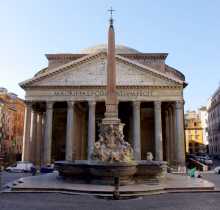 Macuteo Obelisk and Pantheon Macuteo Obelisk and Pantheon
|
In the movie "Angels & Demons" (2009), there is a scene of the outside Pantheon including the obelisk, when the professor Robert Langdon (Tom Hanks) misguidedly comes here. In the movie "Roman Holiday" (1953), Princess Ann (Audrey Hepburn) and an American newspaper reporter Joe Bradley (Gregory Peck) goes to the downtown Rome, and the Princess orders costly champagne for lunch, and meet a photographer friend Irving Radovich (Eddie Albert) at the sidewalk cafe next to the Pantheon. However, it's known this cafe wasn't really here and the film scene was took at the set of Cinecittà Studio.
How To Get There:
In the case of Metro, take a Line "A" from Termini, and getting off at Barberini is the comparatively close, but we need to walk about 700 meters from the station. In the case of bus, take #70 (for Clodio), and get off at Senato, and then about 300 meters east.
Since the Piazza della Rotonda is just north of well-known Pantheon, you should say "Pantheon" when if you ask somebody the direction.
The obelisk stands at the center of the Piazza della Rotonda.
The square is about 400 meters from Agonalis Obelisk of Piazza Navona. The northeast side of Agonalis obelisk, there is a narrow alley to exit on the east side ahead when viewed standing Sant'agnesee in Agone church in the back. In the alley of the end of the street, we can look the Madama Palace (Palazzo Madama) which is used for the Senate of the Italian Parliament, which flys the Italian and EU flags. Turn left at Corso del Rinasscimento, and then immediately turn right, that's Via del Salvatore, which is the left side of the Palace. Go strait, the name of street changes to Via Giustiniani, and then arrive the Piazza della Rotonda ahead. It would be only 10 minutes or so even if we saunter from Piazza Navona, looking the stores and buildings along the street. I walked this course when I revisited here in August 2014.
About The Obelisk:
It's small as 6.34 meters for obelisk itself, 14.25 meters including pedestal. It's estimated about 1 meter at base was missing.
This obelisk was originally erected in front of the Temple of Ra in Heliopolis, by Ramses II, as the pair of another obelisk which is now in Celimontana.
The pair obelisks were carried to Iseum, the Temple of Isis in the ancient Rome and erected there. But it is unknown what happened after that.
In 14th century (1373 or 1374), the obelisk was found underground near of Piazza di San Macuto, which is about 300 meters east of Pantheon. Therefore, this obelisk is called "Macuteo Obelisk (Obelisco Macuteo)". Then, this was erected in Santa Maria in Ara Coeli (church), which is next to Capitoline Museums (Musei Capitolini) in Rome.
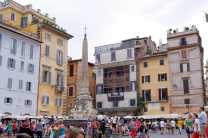 | |
|
The Piazza della Rotonda
in the afternoon. |
On the other hand, there was large fountain (Acqua Vergine Fountains) which was designed by Giacomo Della Porta, constructed by Leonardo Somani in 16th century, at the center of Piazza della Rotonda. In 17th century, the Piazza was renovated in 17th century by Pope Alexander VII (Alessandro VII). Then, in 18th century, Pope Clemens XI decided to move the obelisk [of Santa Maria in Ara Coeli] to Piazza della Rotonda, in front of Pantheon. Italian sculptor of Baroque period Filippo Barigioni added the star and the Christian Cross on the apex of th obelisk in 1711, and erected it on the center of large fountain. The fountain of dolphin was also created by Vincenzo Felici, and placed at four corners of the fountain.
Separate from dolphins, the fountains designed of human face under the pedestal (designed by Giacomo Della Porta) are also interesting as each face shows different strange expression.
All four sides, one line hieroglyph is inscribed. Except the west side, three sides of hieroglyph are well-preserved, and the horus name, coronation name and birth name of Ramses II can be clearly read, but it makes us a half-finished feeling, because the bottom portion is missing. The engraving on west side is poor made, and marks imitated the hieroglyph are inscribed. This is estimated that such engraving was repaired after the obelisk came to Rome.
Notes For Pictures:
Since the Piazza is one of the top tourist destinations in the Rome, it is always crowded in the daytime. Especially under blazing sun of summer, and people wash their face in the water of the fountain in the daytime, and take rest in the shade. So, it's difficult to calmly take the photo of Obelisk and fountain. The upper right photo was taken in the afternoon of summer 2013. If you wish to take photo without people, it should be early in the morning before tourists come to the Piazza.
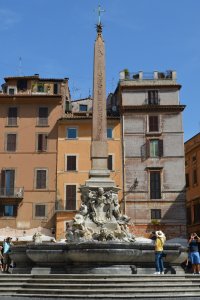 South Side |
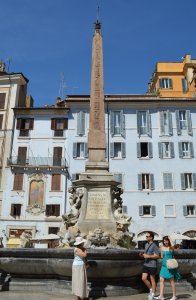 East Side |
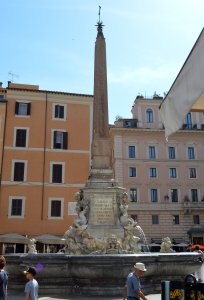 West Side |
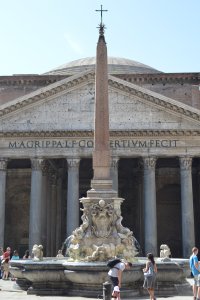 North Side |
|||
August 11, 2014 by Hiroyuki Nagase (For high definition image, please click the picture) | ||||||
Copyright Hiroyuki Nagase nagase@obelisks.org and Shoji Okamoto okamoto@obelisks.org